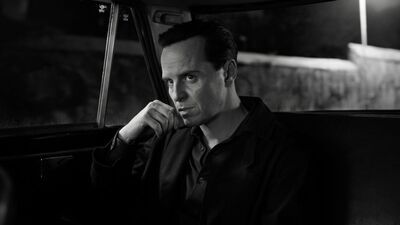The phenomenal Andrew Scott, who should have won an Oscar this year for his work in “All of Us Strangers” but is probably still best-known for “Fleabag” and “Sherlock,” puts his stamp on a Tom Ripley that has been transported to the 1960s. Unlike some versions of this story, but truer to Highsmith, this Ripley is a con artist from the very beginning. Other Ripleys have been creatures of their situation, whether it’s Alain Delon’s passionate vengeance in “Purple Noon” or Matt Damon’s emotional outbursts of violence in “The Talented Mr. Ripley.” Scott’s Ripley is a predator. What we see of him in New York is low-level scam crime, but there’s something barren and dead behind this Tom Ripley’s eyes, a sense enhanced and even embodied in the gorgeous black-and-white cinematography from Robert Elswit (“There Will Be Blood”). The Talented Mr. Ripley has often been adapted in a way that felt sweaty, hot, and impassioned—this one is ice cold, drained of color and most human emotion. The choice really serves the reading of Ripley as an amoral creature, someone who doesn’t cross boundaries of right and wrong as much as he never even considers them.

The set-up will be familiar to anyone who has read the Highsmith or seen the films. Ripley is asked by a shipping magnate to find his son in Italy, a young man named Dickie Greenleaf (Johnny Flynn), who is wasting away the family money and his life with a friend named Marge Sherwood (Dakota Fanning). The aspects of Greenleaf’s playboy lifestyle are here in this version but toned down by Zaillian. This isn’t a story of someone being drawn to unimaginable excess, which adds to the sociopathic nature of Ripley here. Without spoiling, he takes drastic action to hold onto his new life in Italy early in the 8-episode run, dodging the authorities and Marge over the rest of the show. Eliot Sumner has an interesting take on Freddie Miles while Maurizio Lombardo is very effective as Inspector Pietro Ravini.
If Andrew Scott is the lead of “Ripley,” Elswit’s cinematography is the Best Supporting Actor. The man who shot “Boogie Nights,” “Magnolia,” “Good Night, and Good Luck,” “Michael Clayton,” and so many more brings a visual confidence to “Ripley” that’s unlike anything else on TV. He alternates gorgeous shots of one of the most beautiful countries on Earth in Italy with the vast interiors that hide a man like Tom Ripley. Zaillian’s direction is stellar too, especially in the explosive moments. The way the key encounter between Tom and Dickie—along with the aftermath—is staged and executed is breathtaking. A great score by Jeff Russo (who did masterful work on the TV version of “Fargo”) also deserves credit for the mood it sets.

